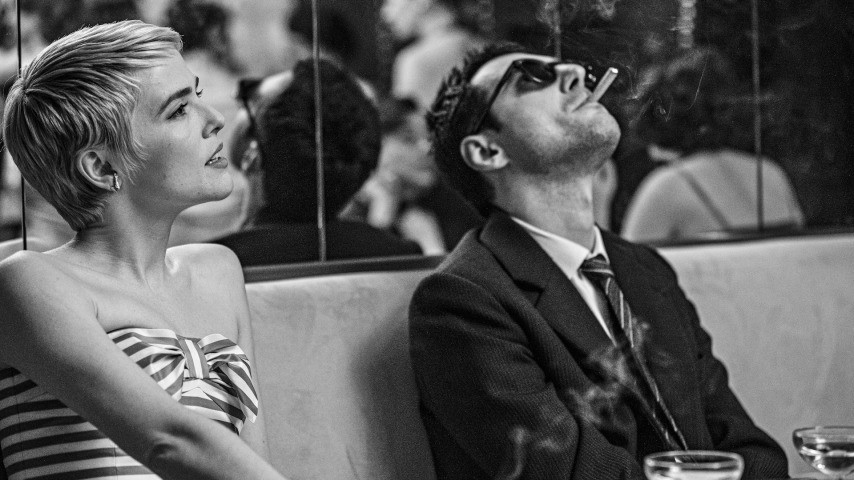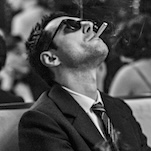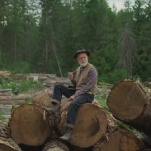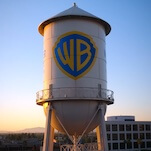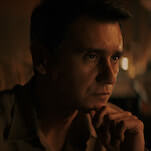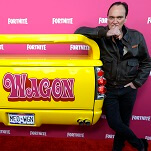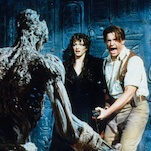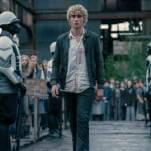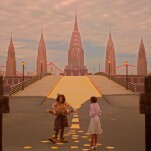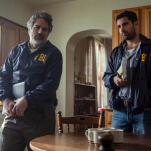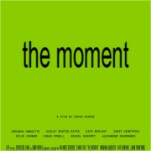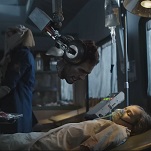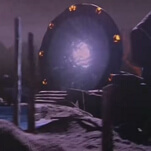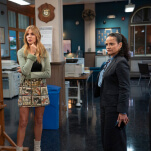Jean-Luc Godard opened his film Contempt with a quote: “The cinema,” said André Bazin, “substitutes for our gaze a world more in harmony with our desires.” Fittingly for Godard, it is a misquote, coming not from Bazin but Michel Mourlet, the leader of a sect of cinephiles within the Cahiers du Cinéma, dubbed “Mac-Mahonists” after their Parisian theater gathering place. Godard’s (probably intentional) miscitation simultaneously cemented Mourlet’s cinematic legacy while erasing the writer himself, just as Breathless‘ filming outside the Mac-Mahone, or that film’s dedication to Poverty Row studio Monogram Pictures, leaves a trail of breadcrumbs to a particular corner of Paris’ cinephilic culture. So, too, does Richard Linklater’s dramatized version of Breathless‘ production, Nouvelle Vague, which seeks to recreate that explosive moment in film history dishonestly—not by bending the truth of its production, but betraying Godard’s form.
There’s an irony in recreating Godard’s paradigm-shifting Breathless. The infectious spontaneity of Godard’s film is anathema to Linklater’s deceptively calculated approach—not just on the surface, but in the moving parts bringing it together. Breathless is Godard’s outlier film; it is his messiest, most cobbled-together work where he truly did not know how to make a movie. He played into that to make something wholly new. Linklater, despite the casualness that he and his films present, is an exacting filmmaker, who uses extensive rehearsals to lock down performances to the word. Both ultimately became precise filmmakers, but Linklater is a master of replicating the look and feel of spontaneity while Godard was always experimenting with how to create the conditions for a film to reveal itself.
This tension in Linklater’s work—that feeling of the present unfolding, but under the condition of a controlled cinema—is both unresolvable and the magic of the resulting films. In director’s commentaries, Linklater often harps on people talking about the “improvisatory” nature of his films when, in fact, they are tightly plotted in order to create his particular brand of veracity. On the Criterion release of Dazed And Confused, his first non-DIY production, Linklater talks about arguing with producers about the organization of the shooting schedule, demanding ample rehearsal time before the camera rolled.
Many place Linklater’s domain as being the “hangout movie,” even if that doesn’t mean much. Edo Choi, writing for Reverse Shot, points out that “no two of his entries in this vaguest of subgenres…is quite alike.” Choi also points to a unifying node in Nouvelle Vague with the rest of Linklater’s cinema: Its focus on artists. Linklater considers this film part of a cycle with Me And Orson Welles, Where’d You Go, Bernadette?, and Blue Moon, although one could just as easily point to the various musicians and amateur filmmakers dotting the corners of Slacker—even Jack Black’s wannabe rock star in School Of Rock.
But Nouvelle Vague does stand out among Linkater’s films, at least aesthetically. But simply focusing on the run-and-gun, black-and-white look of the film would miss how much its approach fits perfectly into Linklater’s oeuvre. Linklater is often thought of in relation to time, but he should also be thought of as a master at setting in time. Slacker‘s present-tense Austin is just as important as Dazed And Confused‘s past-tense one, and feels just as authentic, as if portraying the present was just as complex and intricate as trying to recreate the past.
For Nouvelle Vague, Linklater and cinematographer David Chambille recreated the rough textures of a film print from 65 years ago, like the movie was really some unearthed behind-the-scenes footage. Meanwhile, they are using digital effects to make 2024 Paris look how it did in 1959—from making backgrounds and inserting cars to reverting a paved street back to cobblestones. It all serves Linklater’s usual focus on era, which never narratively pretends to be comprehensive but is always a cross-section: We don’t see whole lives in Linklater films, but glimpses as they are lived (even Boyhood is stitched together in ellipses). Nouvelle Vague, then, is not a biopic of Jean-Luc Godard or Breathless or even the French New Wave, but Linklater trying to recreate all of that lightning so he can put it in a bottle.
There is another fundamental contradiction to Nouvelle Vague, best highlighted by the sequence where they are shooting a scene on the Champs-Élysées between Jean Seberg (Zoey Deutch) and Jean-Paul Belmondo (Aubry Dullin). A passerby asks Godard (Guillaume Marbeck) what they are filming, to which he responds, “A documentary about Jean-Paul Belmondo and Jean Seberg acting out a fiction.”
It’s a transposition of Godard’s famous notion that “every film is a documentary of its actors,” which is itself an update of Bazin’s concept that “every film can be considered a social documentary.” Nouvelle Vague, like so much of Linklater’s work, is simultaneously a document of its Hollywood star (Deutch) paired against a host of newcomers—Marbeck and Dullin, but also the likes of Adrien Rouyard (as François Truffaut), Antoine Besson (Claude Chabrol), and Jodie Ruth-Forest (Suzanne Schiffman)—while also constantly couching its story about cinematic spontaneity in stringent recreation.
“I knew how many takes they did of each scene. So, I was recreating that,” Linklater told Filmmaker. “The scene where [Jean-Paul Belmondo] goes into the phone booth, they did in one take. So, I did that one quick. But the one where he goes to the travel agency is more complicated. I knew [Godard] couldn’t have done it in one take, and sure enough they did four. So, we show them doing take three.” At once, Linklater’s approach is successful because, in action, it does feel like watching one of the greatest fulcrums in film history come to life before our eyes, but it is a particularly ironic approach to achieving it—one which highlights why Godard’s naiveté was successful without ever applying his principles. Godard was always moving in a particular direction to find the truth; Linklater knows exactly where he wants to go in the first place.
And the latter’s influences weren’t just Breathless. In that same interview with Filmmaker, Linklater says that Nouvelle Vague is “like a film made back then, not by Godard but maybe by Jacques Rozier or one of Godard’s other friends.” We do actually know what a Rozier behind-the-scenes of a Godard film would look like, given that his most well-known works (in anglophone cinephilia up until very recent restorations and retrospectives) are his films shot during the making of Contempt: Paparazzi and Bardot Et Godard. Linklater likely wasn’t thinking so literally, but instead had in mind Rozier’s own first feature Audieu Philippine, a loose youth summer film that joyously revels in its performers, often with wonderful sustained sequences not unlike those found in Nouvelle Vague.
With this, Linklater expands beyond just singing Breathless karaoke, and hints at a world much larger than what he narrowly focuses on. The way he opens scenes, too, by filming new additions to the story head-on and introducing them with nameplates fills in the gaps in the scene that would otherwise be background noise to uninitiated viewers and is a kind of catnip for cinephiles—there’s Rivette and Rohmer! Varda and Demy! Michel Mourlet! Most notably absent, though, is Bazin, a figure who looms over all of the New Wave as the literal founder of the Cahiers and the spiritual approach to understanding cinema.
Bazin also looms over Linklater. In a sequence from Linklater’s movie Waking Life, filmmaker Caveh Zahedi actually explains Bazin’s ontology of the image: “Cinema, in its essence, is about the invention of reality. Reality is actually reproduced.” This is at the heart of what Linklater reaches for in his approach to realism, but the reconstruction of reality in Breathless in particular feels like an attempt at having his cake and eating it too—portraying spontaneity while living in the shadow of it. And maybe it is unfair to think that Nouvelle Vague had Godardian ambitions in the first place, given how open Linklater is about their differences.
Linklater sees his own more naively confident younger self in Godard—both made their most lasting and influential films first, and both have subsequently been thought by broader cinephilia less as constantly evolving artists but static images of their earlier selves. Still, Linklater is a good enough filmmaker that he can make something like Nouvelle Vague into a cute curio even if it does undermine the work it admires. And yet, it will inevitably inspire newer cinephiles to reach their hands deeper into the wells dug by both Godard and Linklater; this is the kind of movie many modern movie obsessives would have wanted to watch in high school.
Breathless is a film which doesn’t work in its own right, both intentionally and unintentionally, but is so remarkable because Godard knew this, pushing his failures away while placing his successes in the forefront. A simple crime film suddenly turned into an endlessly inventive romp which forced the viewer to consider the very nature of the film at every turn. Godard’s cinema would continue constantly reinventing itself. Linklater, on the other hand, is only looking further and further backward (he is currently trying to get a film off the ground about 19th-century transcendalists). Even when his films take place in the present, Linklater always feels like he is looking to the past, while Godard was constantly propelling himself into the future.
